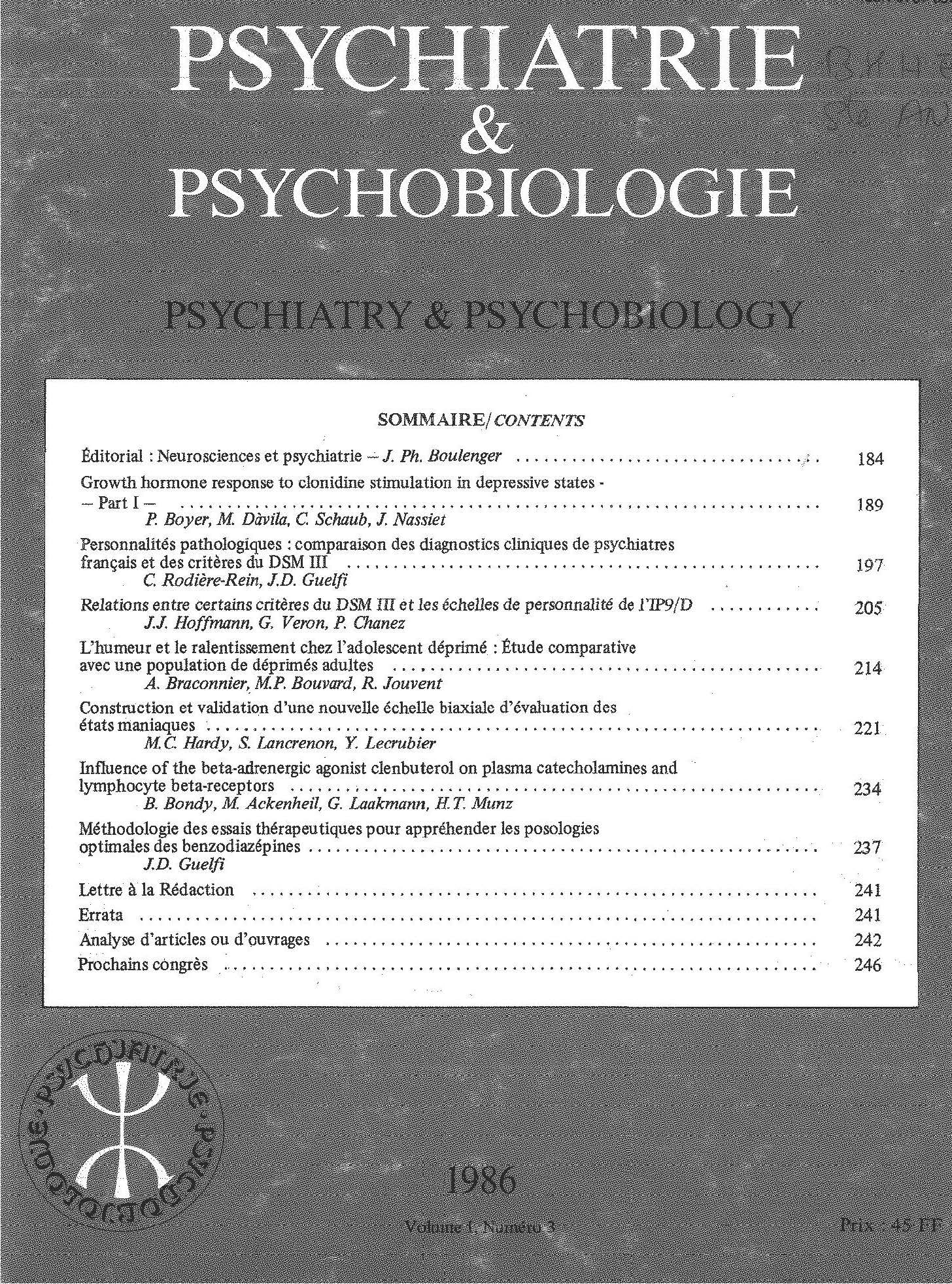No CrossRef data available.
Article contents
Traitements antidépresseurs (amitriptyline et oxaprotiline), éléments psychopathologiques prédictifs de l'efficacité thérapeutique
Published online by Cambridge University Press: 28 April 2020
Résumé
La valeur prédictive du diagnostic et de la symptomatologie a été étudiée chez 42 malades hospitalisés souffrant de troubles dépressifs majeurs et traités par antidépresseurs (oxaprotiline ou amitriptyline). A 4 semaines de traitement, le score à l'échelle de dépression de Hamilton (17 items) a été pris comme critère d'amélioration : étaient considérés comme améliorés les sujets dont le score était ≤ 9, et comme non améliorés ceux dont le score était > 9. L'intensité de la dépression avant traitement était comparable dans les deux groupes. La sémiologie de la dépression a été évaluée aussi par une échelle plus complète, l'EADM 1 (Pichot et Coll.) qui permet d'établir un profil syndromique à 7 facteurs : «humeur et idéation dépressive», «plaintes subjectives», «agitation névrotique», «ralentissement psychomoteur», «plaintes somatiques», «anxiété» et «troubles de l'appétit».
Ni les sous-groupes diagnostiques (endogène/non endogène) ni l'opposition agitation/ralentissement ni le sexe ni les traitements ni les taux plasmatiques d'amitryptiline ne différenciaient les deux groupes de sujets (améliorés et non améliorés). L'âge des sujets améliorés était significativement plus élevé. Les taux plasmatiques moyens d'oxaprotiline étaient significativement plus élevés dans le groupe des sujets améliorés.
Deux facteurs de l'EADM 1, le facteur 1, humeur et idéation dépressive et le facteur 5, plaintes somatiques, permettaient par analyse discriminante un classement correct de 79 % des malades par rapport au critère d'amélioration. Un score élevé avant traitement au facteur 1 joint à un score bas au facteur 5 indiquaient un bon pronostic à 4 semaines.
Summary
The predictive value of diagnosis and symptoms was evaluated in a group of 42 depressed inpatients (major depressive disorder) treated with oxaprotiline or amitriptyline. After 4 weeks of treatment, the HDRS*(17 items) score was used to separate the group into responders (HDRS ≤ 9) and non-responders (HDRS > 9). HDRS scores at the beginning of treatment showed no difference between the 2 groups. Symptoms of depression were also noted on a more comprehensive rating scale, EADM1 *(Pichot et al.), which establishes a syndromeprofile with 7 factors: 1. depressed mood, 2. subjective complaints, 3. neurotic agitation, 4. psychomotor retardation, 5. somatic complaints, 6. anxiety, and 7. disturbance of appetite.
Diagnostic sub-groups (endogenous/non-endogenous), clinical ratings of agitation/retardation, sex, drug treatment, and plasma-levels of amitriptyline did not differentiate responders from non-responders, but responders were significantly older than non-responders and had higher oxaprotiline plasma levels.
Two factors of the EADM 1 rating scale: factor 1, depressed mood, and factor 5: somatic complaints, allowed 79 % of the patients to be correctly classified by discriminant analysis. A high score on factor 1 associated with a low score on factor 5 before treatment predicted a good treatment response after 4 weeks.
Keywords
- Type
- Research Article
- Information
- Copyright
- Copyright © European Psychiatric Association 1986
Footnotes
*HDRS : Hamilton Depression Rating Scale
EADM 1 : Echelle d'Appréciation de la Dépression et de la Manie



Comments
No Comments have been published for this article.